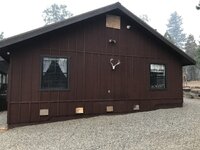After seeing the wildfire devastation in southern California over the last week, I was hoping that there would be some knowledgeable homeowners or wildland or structure firefighters on the site to give me some advice. I live in a location that is one house back from public greenspace that has cheatgrass, sage and other combustibles that come right up to my neighbor's property line. We've had more than a few close calls with range fires in fairly close proximity to our Boise neighborhood over the years and I'm contemplating purchasing some personal firefighting equipment to protect our house should the need arise. We have an inground pool with a capacity of around 17,000 gallons and a fire hydrant 200 feet away from the front of our house. As we all saw in the southern California situation, cities cannot be depended upon to have the infrastructure in place to guarantee that there is going to be adequate water at a hydrant or adequate manpower to fight a fire should numerous structures be burning at the same time . Thus, my desire to have something in place (however potentially inadequate it may be) to have a fighting chance to save our property should the need arise.
Here's my equipment list so far:
Waterax Mini-Striker High-Pressure Fire Pump (this is a gasoline powered portable unit)
Priming device
A section of hard line to supply water from our pool to the pump
A couple sections of discharge hose to reach around to the front of our house from the pump
A nozzle for the discharge hose
Do I need turnout gear in this situation? I know that structure firefighters wear it, but wildland guys appear to wear clothing with Nomex fire resistant fabric.
Thanks for your thoughts on this subject. Suggestions welcome.
Here's my equipment list so far:
Waterax Mini-Striker High-Pressure Fire Pump (this is a gasoline powered portable unit)
Priming device
A section of hard line to supply water from our pool to the pump
A couple sections of discharge hose to reach around to the front of our house from the pump
A nozzle for the discharge hose
Do I need turnout gear in this situation? I know that structure firefighters wear it, but wildland guys appear to wear clothing with Nomex fire resistant fabric.
Thanks for your thoughts on this subject. Suggestions welcome.
Last edited:


